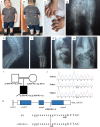A novel homozygous variant in CANT1 causes Desbuquois dysplasia type 1 in a Chinese family and review of literatures
- PMID: 32922611
- PMCID: PMC7476945
A novel homozygous variant in CANT1 causes Desbuquois dysplasia type 1 in a Chinese family and review of literatures
Abstract
Desbuquois dysplasia (DBQD) is a severe chondrodysplasia characterized by short stature, retarded development, multiple joint dislocations, and a distinct radiological appearance of the proximal femur. Pathogenic variants in the calcium-activated nucleotidase 1 (CANT1) or xylosyltransferase 1 (XYLT1) gene have been previously reported to cause DBQD. Here we present a 12-year-old boy manifesting the typical features of DBQD type 1 caused by a homozygous intronic variant c.836-9G>A of CANT1. To our knowledge, this is the first DBQD case described in China revealing that a CANT1 variant was also responsible for DBQD in the Chinese population and further emphasizing the role of CANT1 variants in the etiology of DBQD type 1. Our finding provides certainty for the DBQD clinical diagnosis of this patient and expands the spectrum of known DBQD genetic risk factors. On the basis of this study, amniocentesis-based prenatal diagnosis or preimplantation genetic diagnosis (PGD)-based assisted reproduction could be a helpful aristogenesis strategy to avoid the birth of a DBQD affected child.
Keywords: CANT1 variant; Desbuquois dysplasia; aristogenesis; clinical diagnosis.
IJCEP Copyright © 2020.
Conflict of interest statement
None.
Figures

Similar articles
-
Clinical and Genetic Insights into Desbuquois Dysplasia: Review of 111 Case Reports.Int J Mol Sci. 2024 Sep 7;25(17):9700. doi: 10.3390/ijms25179700. Int J Mol Sci. 2024. PMID: 39273648 Free PMC article. Review.
-
Cloning, expression and enzyme activity delineation of two novel CANT1 mutations: the disappearance of dimerization may indicate the change of protein conformation and even function.Orphanet J Rare Dis. 2020 Sep 9;15(1):240. doi: 10.1186/s13023-020-01492-8. Orphanet J Rare Dis. 2020. PMID: 32907608 Free PMC article.
-
A novel CANT1 mutation in three Indian patients with Desbuquois dysplasia Kim type.Eur J Med Genet. 2015 Feb;58(2):105-10. doi: 10.1016/j.ejmg.2014.11.006. Epub 2014 Dec 5. Eur J Med Genet. 2015. PMID: 25486376
-
Endoplasmic reticulum retention of xylosyltransferase 1 (XYLT1) mutants underlying Desbuquois dysplasia type II.Am J Med Genet A. 2017 Jul;173(7):1773-1781. doi: 10.1002/ajmg.a.38244. Epub 2017 Apr 30. Am J Med Genet A. 2017. PMID: 28462984
-
Further Defining the Phenotypic Spectrum of B3GAT3 Mutations and Literature Review on Linkeropathy Syndromes.Genes (Basel). 2019 Aug 21;10(9):631. doi: 10.3390/genes10090631. Genes (Basel). 2019. PMID: 31438591 Free PMC article. Review.
Cited by
-
Clinical and Genetic Insights into Desbuquois Dysplasia: Review of 111 Case Reports.Int J Mol Sci. 2024 Sep 7;25(17):9700. doi: 10.3390/ijms25179700. Int J Mol Sci. 2024. PMID: 39273648 Free PMC article. Review.
-
First Report of Two Egyptian Patients with Desbuquois Dysplasia due to Homozygous CANT1 Mutations.Mol Syndromol. 2021 Aug;12(5):279-288. doi: 10.1159/000516607. Epub 2021 Jul 22. Mol Syndromol. 2021. PMID: 34602954 Free PMC article.
References
-
- Huber C, Oules B, Bertoli M, Chami M, Fradin M, Alanay Y, Al-Gazali LI, Ausems MG, Bitoun P, Cavalcanti DP, Krebs A, Le Merrer M, Mortier G, Shafeghati Y, Superti-Furga A, Robertson SP, Le Goff C, Muda AO, Paterlini-Brechot P, Munnich A, Cormier-Daire V. Identification of CANT1 mutations in Desbuquois dysplasia. Am J Hum Genet. 2009;85:706–710. - PMC - PubMed
-
- Furuichi T, Dai J, Cho TJ, Sakazume S, Ikema M, Matsui Y, Baynam G, Nagai T, Miyake N, Matsumoto N, Ohashi H, Unger S, Superti-Furga A, Kim OH, Nishimura G, Ikegawa S. CANT1 mutation is also responsible for Desbuquois dysplasia, type 2 and Kim variant. J Med Genet. 2011;48:32–37. - PubMed
-
- Faden M, Al-Zahrani F, Arafah D, Alkuraya FS. Mutation of CANT1 causes Desbuquois dysplasia. Am J Med Genet A. 2010;152A:1157–1160. - PubMed
-
- Faivre L, Cormier-Daire V, Eliott AM, Field F, Munnich A, Maroteaux P, Le Merrer M, Lachman R. Desbuquois dysplasia, a reevaluation with abnormal and “normal” hands: radiographic manifestations. Am J Med Genet A. 2004;124A:48–53. - PubMed
-
- Kim OH, Nishimura G, Song HR, Matsui Y, Sakazume S, Yamada M, Narumi Y, Alanay Y, Unger S, Cho TJ, Park SS, Ikegawa S, Meinecke P, Superti-Furga A. A variant of Desbuquois dysplasia characterized by advanced carpal bone age, short metacarpals, and elongated phalanges: report of seven cases. Am J Med Genet A. 2010;152A:875–885. - PubMed
LinkOut - more resources
Full Text Sources
Miscellaneous
